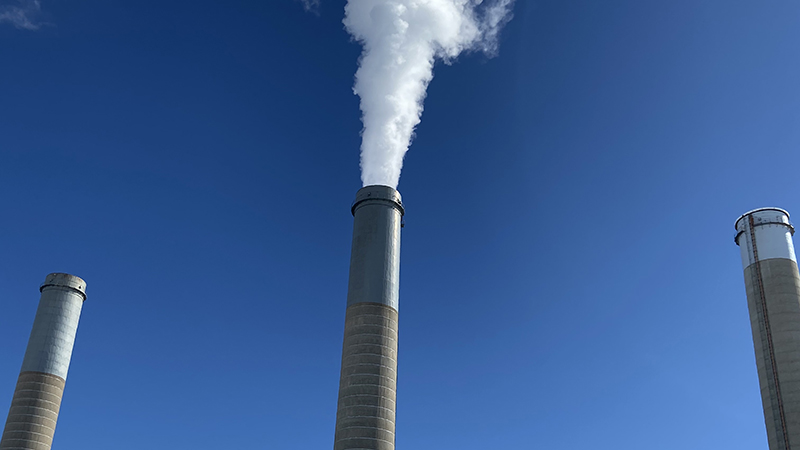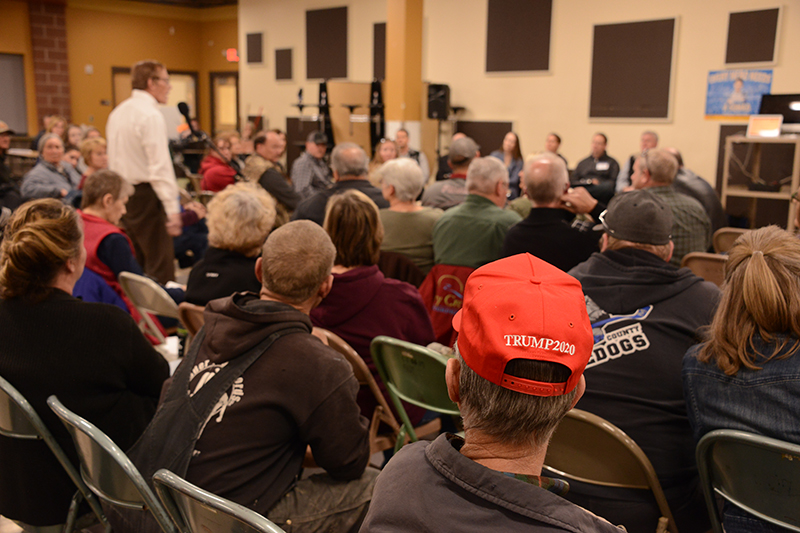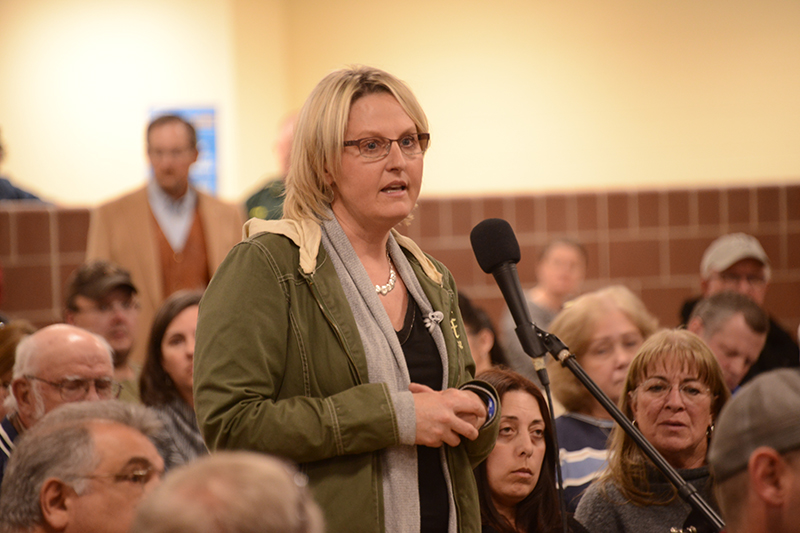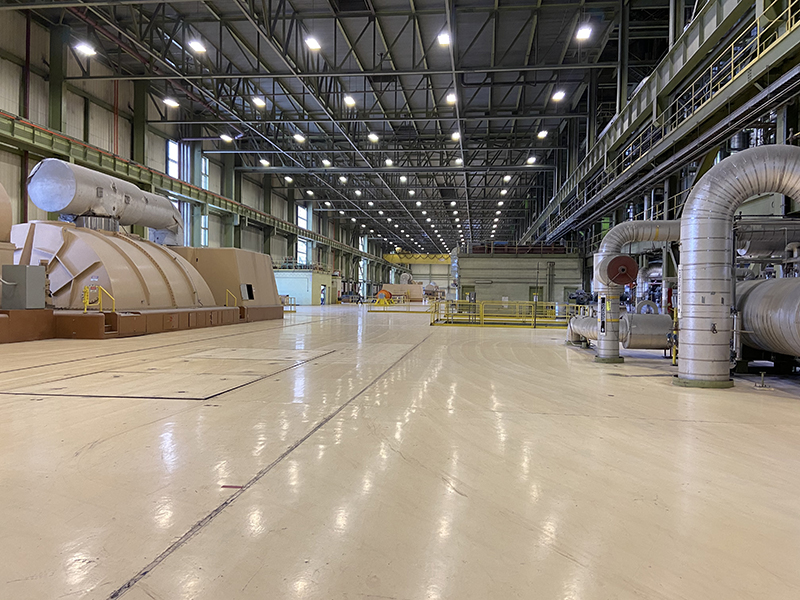
The closure of Craig Station, shown here in March 2020, will hurt. But some people in town see reasons for hope. Photo by Kristin Jones
The closure of Craig Station, shown here in March 2020, will hurt. But some people in town see reasons for hope. Photo by Kristin Jones
If there was one thing everyone agreed on in Craig back in early March, it was that predicting a future without coal was impossible.
Two months earlier, the operator of the Craig Station power plant said it would close one of its units by 2025, and the other two by 2030. The coal-fired plant is the economic engine of this city of 9,000 in northwest Colorado. The move by Tri-State Generation and Transmission threatened 300 jobs tied directly to the plant and over 400 more who worked for it indirectly, for instance as truckers or railroad workers. Two coal mines feeding the plant would also close down.
But that wouldn’t be a full tally of the losses.
Jennifer Holloway, executive director of the Craig Chamber of Commerce, said they started listing the businesses in town that would be impacted—hotels, restaurants, health care and child care providers—“and we just stopped, because it’s going to be everybody.”
Craig residents packed a school auditorium to offload their concerns before a visiting advisory committee to the Office of Just Transition, a state effort to ease the pain of Colorado workers and communities affected by the worldwide decline in coal. Their union jobs were disappearing; their health care benefits were going away for good. There was a mental health crisis in full boil.
Days later, another profound shock hit the community—this one without warning. In Craig, as in other communities across the country, the national spread of the coronavirus shut down schools, restaurants and businesses. Craig Memorial Hospital—the city’s other big employer—experienced a precipitous drop in revenue as non-essential procedures were called off.
Craig looked doomed.
But the year’s surprises didn’t stop there. Perhaps the biggest surprise over the last few months is the way that Craig has adapted to the shocks of 2020. Some people in the town see a lesson in resilience that is as applicable to the decline of coal as it is to a global pandemic.
A time to grieve
“I’m from the government and I’m here to help” is a message that the largely conservative community of Moffat County is primed to reject out of hand.
Wade Buchanan, head of the Office of Just Transition, had the unenviable job of delivering precisely that message without using those words.
He was only partly successful.
“We’re here to help you think through what your future should and can look like, and we’re here to figure out how the state can be helpful in that process,” Buchanan told a crowd of several hundred Craig residents who had assembled on March 4.
His office, created last year by state legislation, has a mandate to protect workers and usher in new economic development to the areas of Colorado hardest hit by the closure of coal plants and mines. Despite promises from the Trump administration to revive the nation’s coal communities, competition from low-cost natural gas and a shift in demand for renewable energy have decimated the industry.
Many people in Craig put the blame squarely on policies coming out of Denver, where Gov. Jared Polis has set a goal of 100% renewable energy by 2040.
The visit to Craig from an advisory committee to the Office of Just Transition—made up of legislators, labor department officials, union representatives, economic development experts and affected workers and community leaders—was a chance to express that view.

Residents of Craig, Colo. packed a March 2020 meeting to talk about a future without coal. Photo by David Cornwell
“The people of Denver are doing nothing about the CO2 they are creating with tailpipe pollution. They create more tailpipe pollution than this plant does, and they are doing nothing about it. Less than 4% of Denverites use mass transit that we just spent $6 billion on,” said Craig resident Ran MacDonald. “Somebody’s got their priorities wrong.”
(It’s actually $7.5 billion. And while 40% of downtown Denver employees commuted by public transit in 2019, the 4% number was about right for the Denver-Aurora-Lakewood metro area combined. That was before the pandemic, of course. Now ridership is much lower.)
The meeting was meant to give the advisory committee ideas for supporting a future without coal. But the people of Craig weren’t done grieving an industry that had fed the town for decades. What new industry or economic initiative could ever match what the union jobs at the coal mines and power plant provided here?
Allan Brown had dropped out of college and accumulated $30,000 in credit card, student loans and other debt when he went to work as a coal miner in 2011. He started at $18 an hour, but quickly found that he could work nearly unlimited overtime, while his wages quickly rose.
“You can make a damn good living at $30 an hour,” said Brown. That, plus the vacation time, make a huge difference in a person’s quality of life, he said. “I don’t know any other companies around that will pay $35 to $50 an hour.”
And then there are the benefits. In a time when many Americans worry about premiums, copays and other health care expenses, Amanda Ott, who is married to a coal miner, said she paid no health care costs at all for her family of five.
Rip the carpet away, and you could expect things to fall.
Jade Wilhite, who works in human resources at the coal plant, saw it firsthand.
“I’ve had tears. I’ve had concerns. We’ve had people acting differently than they normally do,” said Wilhite. “Relationships are breaking down.”
It’s not just workers who were affected, either.

Nurse practitioner and Craig resident Janelle K. Hoaglund said community members’ health was impacted by stress and uncertainty. Photo by David Cornwell
“We don’t think about the mental health impact,” said Janelle K. Hoaglund, a psychiatric nurse practitioner working at a private practice in Steamboat Springs. She worried about kids who were watching their parents struggle with the uncertainty of not knowing where they would work, or whether they would have to move.
People who showed up to the meeting had plenty of ideas for new industries here. How about hosting an agricultural research center with a focus on low-water farming? Manufacturing carbon fiber? Improving the riverfront and promoting Craig as a destination for outdoor adventure? Making use of the subsidies available for solar energy development?
Kendre DiPietro, a power plant engineer, offered a whole list of them herself: Improving the rail connection between Craig and Steamboat Springs to support passenger trains; making use of the water rights owned by the power provider, rather than selling them to the highest Front Range bidder; rehabilitating the land now occupied by the power plant so that it’s clean, usable and attractive.
Still, she wasn’t sure how realistic this would be. “It’s all expensive,” she told me later.
It was hard to know whether all this spitballing would lead to something. It was hard to know if the city would survive at all.

Craig Station, March 2020. Photo by Kristin Jones
The shocks of 2020
The Candlewood Suites hotel in Craig is precisely the kind of place most likely to be affected by the closure of the coal plant, and the people who work there know it.
Craig has never been much of a tourist destination, despite the pretty landscape and Moffat County’s 2 million acres of public lands. The visitors who stay at Candlewood Suites are mostly contractors at the power plant and other kinds of visiting workers who like that the rooms have kitchens, and don’t mind that there’s no breakfast.
When the pandemic hit, a lot of the staff was furloughed right off the bat.
Kimberly Davis, the front desk manager, was one of them. She took a furlough voluntarily because of health issues that made her nervous about being in the hotel. “I felt like it was the best choice to make at the time,” she said.
For nearly two months, she stayed home and helped her 11-year-old son with remote schooling. She came back the day after Mother’s Day, when she finally felt safe to do so. When she returned, the dynamic at work felt different.
“Everybody’s stressed to the max,” she said. “It’s the things [guests] are complaining about that we’ve never seen. People are nervous, scared, stressed. I got tanked [in a guest survey] because somebody didn’t have a bar of soap in his room. It would have taken five seconds to request one and we would have run down five. We’ve had to re-educate our front desk staff about being empathetic.”
Late in the summer, four people died by suicide in Moffat County, the Colorado Sun reported. Some are blaming the twin crises of the coal industry decline and the pandemic.
Amid all of that, Davis doesn’t know exactly what to make of another strange fact of this year: business is booming.
“I’m having a record year this year,” she said, “which is unbelievably ridiculous because of what’s going on.”
New construction on a high-speed internet connection and road work brought a whole slew of workers in. Work that was scheduled at the power plant in March and April was put off until the late summer and early fall. Elk hunting season has started, and the hotel has been turning people away.
And there are signs that this isn’t just a fluke. In June, international hotel group Valor Hospitality bought the hotel from Mars Hospitality. Valor has previously focused on urban markets like Cape Town, South Africa and Brooklyn, New York, and saw its venture into the Rocky Mountain area, including the Candlewood Suites in Craig, as “targeted on immediate needs as we fight back post COVID-19,” according to the company’s press release.
The Moffat County Tourism Association has been trying for years to make the area’s natural secrets a little less well-kept. (Wild horse herds of the Sand Wash Basin, anyone?) Early on, the pandemic brought the lodging revenue that funds the tourism association down to virtually zero, said Tom Kleinschnitz, who heads the association. Dinosaur National Monument’s timed reservation system—a response to the coronavirus—put up an immediate roadblock.
But in recent months, as airplane travel has atrophied worldwide, the area has seen an influx of regional tourists seeking remote locales and new adventures that they can reach by car. Browns Peak Wildlife Refuge has brought in a record number of visitors, said Kleinschnitz.
Sales taxes are actually up. Real estate prices are increasing.
The local feeling has ranged from “bottom of the pile” to “sometimes feeling like we might be ok,” said Kleinschnitz.
“Right now, I’m feeling good about our future,” said Andrew Daniels, CEO of Craig Memorial Hospital, where revenue has recovered since the early days of the pandemic. “We’ll be break-even by the end of the year. I wasn’t sure we would be in business back in March.”
“We are not victims”
In August, the advisory committee to the Office of Just Transition submitted its draft plan for public comment.
The community meetings in northwest Colorado in March took on outsized importance because they were the last of their kind; similar meetings planned in Morgan County and Pueblo were scuttled due to the pandemic, said Dennis Dougherty, executive director of Colorado AFL-CIO and the chair of the advisory committee.
The plan calls for training and support, as well as assistance to replace lost wages and health benefits, for coal workers. For communities that are affected, it calls for investment in infrastructure, and the establishment of a statewide investment fund focused on coal communities.
The committee didn’t pare back any of its recommendations because of COVID-19 or the deep revenue cuts that have come along with it, said Dougherty.
“This is going to be a long-term process,” he said. “This is going to be multiple years. There are some people who think maybe there’s a quick fix to this, and there’s not.”
Dougherty said he hopes that because of the pandemic, people are “more aware of the fact that there is a need for a stronger social safety net. Some people are saying, ‘Nobody helped me when my job was automated or moved offshore.’ I empathize, but I also say, there should have been. We’re trying to figure it out so that doesn’t happen anymore.”
Colorado Northwestern Community College is poised to play a big role in the transition, said John Anderson, vice president of student affairs and head of the college’s Craig campus. The school is starting a cybersecurity degree program in response to demand from plant workers for tech offerings. It also expanded its nursing program. Both of those industries are ones that people could pursue anywhere—including in Craig.
Holloway, the head of the Craig Chamber of Commerce, is bullish on the city’s prospects. The worst effects of the pandemic have—so far—spared the city, she notes.
“When this first happened, I thought, shoot, we’re going to lose half our businesses,” she said.
But the miners and power plant workers are considered essential, and never stopped working. Several businesses in town were able to take advantage of the Paycheck Protection Program loans, part of the federal government’s stimulus efforts. The community raised money so that the city’s only real bar, Popular Bar, could start serving food and stay open amid statewide restrictions.
Though the college budgeted for a 20% decline in enrollment amid gloomy national predictions in March, that didn’t come to pass. While community colleges in the metro areas have been hit hard by the pandemic, enrollment here is down just 0.5%, said Anderson.
The chamber of commerce itself had some unexpected luck when the local marketing district gave its ok for a grant that allowed the chamber and the Moffat County Visitor Center to move into a 100-year-old building downtown, reimagined as a co-working space.
The board of the hospital—which expects to have to either contract or expand services outside of Moffat County as a result of the coal transition—has been noticing the positive trends, too, said Daniels.
“Before COVID, I don’t think people realized that rural was a great place to live,” he said. Now, more people are buying houses here: “Maybe it won’t be as bad as we thought. Maybe people will realize that rural has good broadband access and you can work remotely. Maybe that trend will continue and we won’t see a decline. It’s hard to tell. It’s unexpected.”
Crucially, there have been relatively few cases of COVID-19 in the county.
“We’ve been lucky,” said Holloway recently. She knows how quickly that can change.
It’s the certainty that things can change that also brings her hope.
“When I talked to you in March, we were still seeing a lot more resistance in the mindsets of people. There was still a lot of denial, a lot of thinking that we can save coal. I think that’s changing,” said Holloway.
She said she bristled when, during a recent debate between Republican Sen. Cory Gardner and his Democratic challenger, former Gov. John Hickenlooper, Gardner brought up a conversation he’d had with somebody in Craig.
Gardner said the person asked him: “What did I do wrong to lose my job, for the government to tell me that I’m not worthy of this job?”
“I am so sick of us being portrayed as victims,” said Holloway. “We are not victims. The fact is our industry is changing. We need to change that dialogue to, ‘We have been successful at providing electricity—important, important work—and we can do that again’” in a different industry, she said.
People will undoubtedly move away from Craig, said Holloway. But the focus should be on keeping as many of them here as possible during the transition, while they work to build up the multiple industries that will have to step in to take the place of coal—tourism, yes, but also the community college and entrepreneurship.
“People are thinking beyond coal in Craig,” said Holloway. “I feel really positive about that.”